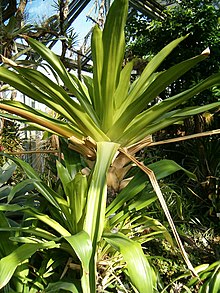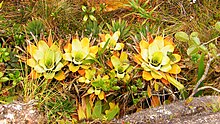Brocchinia
| Brocchinia | ||||||||||||
|---|---|---|---|---|---|---|---|---|---|---|---|---|

Brocchinia cf. reducta natural habitat: Mount Roraima , Venezuela |
||||||||||||
| Systematics | ||||||||||||
|
||||||||||||
| Scientific name of the subfamily | ||||||||||||
| Brocchinioideae | ||||||||||||
| ( GSVarad. & Gilmartin ) Givnish | ||||||||||||
| Scientific name of the genus | ||||||||||||
| Brocchinia | ||||||||||||
| School. & Schult. f. |
Brocchinia is the only genus of plants in the subfamily Brocchinioideae withinthe bromeliad family (Bromeliaceae). The 20 or so species are common in northern South America. Brocchinia species are rarely found in culture, the most common is Brocchinia reducta .
description
Brocchinia species grow as perennial herbaceous plants . The leaves stand together in a leaf rosette. The simple leaves are smooth-edged and have only one end spine.
The inflorescence (inflorescence) grows upright and has green bracts (bracts). The small, inconspicuous flowers are radial symmetry and threefold. The three petals are white to green.
They form capsule fruits with many small, airworthy seeds.
particularities
Carnivory and precarnivory
Brocchinia reducta and Brocchinia hechtioides are different from the other Brocchinia species. With them, the surface of the leaves is slippery, so that possible prey animals slip into the leaf funnel and drown.
So far it has been assumed that both species do not digest themselves with self-produced enzymes (in contrast to the carnivorous plants, the carnivores ), so the plants would need bacteria as a digestive aid. Therefore, these species were only referred to as precarnivorous. In 2005, however, Bartek Plachno from the University of Cracow in Poland demonstrated phosphatase activity in the digestive glands of Brocchinia reducta , which means that this species is to be regarded as carnivorous in the strict sense. No such studies exist yet for the closely related Brocchinia hechtioides , so a precarnivory can currently still be assumed for this species.
"Ant plant"
The species Brocchinia acuminata lives with colonies of ants. The leaves have a swollen base in which the ants nest. There are similar communities in other tropical plant species. Such plant species are called ant plants (Myrmecophytes). The ants' excrement serves as an additional source of nutrients for Brocchinia acuminata . So it is a symbiosis because both organisms benefit from it.
Locations
Most species of the genus Brocchinia grow epiphytically or lithophytically . Few Brocchinia species grow terrestrially . Some species that live on the tepuis grow on bare rocks.
Systematics and distribution
The genus Brocchinia was established in 1830 by Josef August Schultes and Julius Hermann Schultes in Johann Jacob Roemer & Josef August Schultes: Systema Vegetabilium , Volume 7, 2, LXX, p. 1250. The generic name Brocchinia honors the Italian natural scientist Giambattista Brocchi (1772–1826); The first description says: “ Diximus in honorem divi GB Brocchi, Italiae splendidi decoris, qui amore scientiae naturalius deperiit in Nubia. "(Translated:" Dedicated to GB Brocchi, the most splendid celebrity in Italy, who loved the natural sciences and died in Nubia (Egypt). ") Type species is Brocchinia paniculata Schult. f.
The genus Brocchinia was previously assigned to the subfamily Pitcairnioideae . According to molecular genetic studies, it alone forms the subfamily Brocchinioideae. Together with some other genera, it has been classified as a basal group of the Bromeliaceae. A synonym for Brocchinia Schult. & Schult. f. is Ayensua L.B.Sm.
The genus Brocchinia is common in Brazil , Guyana , Colombia and Venezuela .
| About 20 species belong to the genus Brocchinia : |

Habit and leaves of Brocchinia micrantha

Habit and leaves of Brocchinia tatei in the habitat
|
swell
- The Bromeliaceae family on the AP website . (Section systematics)
- Werner Rauh : Bromeliads - Tillandsias and other culturally worthy bromeliads , Verlag Eugen Ulmer, Stuttgart 1990, ISBN 3-8001-6371-3
- Thomas J. Givnish, JC Pires, SW Graham, MA McPherson, LM Prince, TB Patterson: Phylogeny, biogeography, and ecological evolution in Bromeliaceae: Insights from ndhF sequences. In: JT Columbus, EA Friar, JM Porter, LM Prince, MG Simpson: Monocots: Comparative Biology and Evolution. Poales , Rancho Santa Ana Botanical Garden, Claremont, 2006, 23, pp. 3-26.
Individual evidence
- ↑ First publication scanned at biodiversitylibrary.org.
- Jump up ↑ Jason R. Grant: An Annotated Catalog of the Generic Names of the Bromeliaceae , online version from Selbyana , Volume 19, Issue 1, 1998, pp. 91-121.
- ↑ The family of the Bromeliaceae - basal position of the genus. at the AP website.
- ↑ a b c d e f g h i j k l m n o p q r s t u In “Species Index” click on Brocchinia in Eric J. Gouda, Derek Butcher, Kees Gouda: Encyclopaedia of Bromeliads , Version 3.1 (2012 ). Retrieved December 3, 2014.
- ^ Harry E. Luther: An Alphabetical List of Bromeliad Binomials , 2008 (PDF; 321 kB) in The Marie Selby Botanical Gardens, Sarasota, Florida, USA. Published by The Bromeliad Society International.

